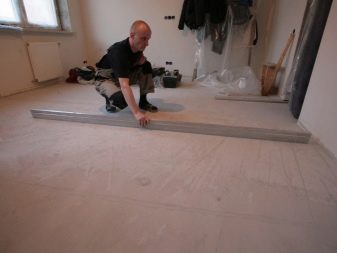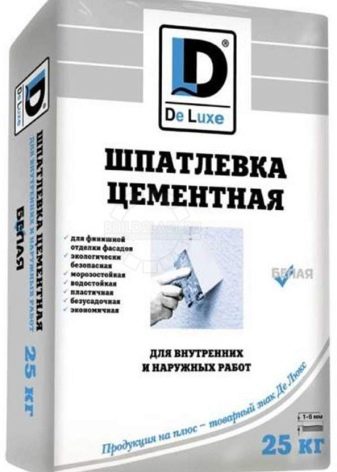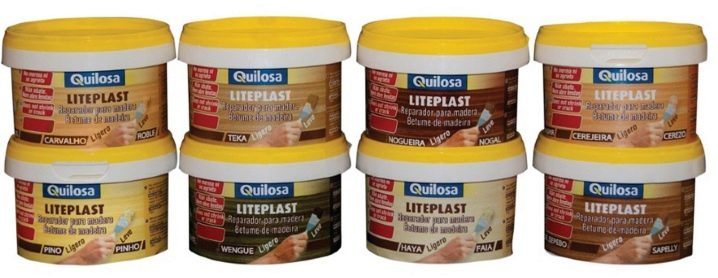The subtleties of applying putty on the floor

The strength of the floor in the room depends on the quality of the material used during installation and the observance of the installation steps of the covering. One of the important steps in the preparation of the substrate is the correct application of the filler to the floor.


Peculiarities
Puttying the floor is carried out to give it greater strength, increase its service life. The work of applying the leveling compound is not difficult, it is only important to know some of the characteristics that the putty should have, among them:
- increased elasticity. This property of the product helps the solution to be evenly distributed over the floor;
- absence in the composition of large parts. The presence of such elements can lead to the formation of scratches on the substrate during the coating process;
- adhesion ability;
- environmental friendliness;
- fire resistance.


Compliance with all requirements is ensured by adding various chemical elements to the putty.
The peculiarity of leveling mixtures is that different products are selected for different coatings. You can achieve perfect evenness of the floor if you correctly carry out the puttying process. Before laying linoleum, the surface must be leveled especially carefully, otherwise all defects will be felt. After the completion of all finishing works, the floor may be constantly exposed to various temperatures, moisture, and the weight of the furniture. To ensure the durability of the coating, only reliable types of product and methods of applying putty should be used.

Views
Today, there is a large selection of mixtures on sale that differ in the composition of the additives. There are these types of putties:
Acrylic
You do not need to add solvents to use it. The composition is a thick paste that can be easily spread over the surface. The disadvantage of the product is poor elasticity at temperatures below zero. But the putty has good adhesion properties. The composition effectively treats the seams, does not emit harmful chemicals, and is resistant to high temperatures.


Polymer
It is made on the basis of water. Suitable for leveling the floor before applying wood flooring. It is enough to putty in one layer, since the composition does not shrink. Differs in high environmental friendliness.


Quick dry mixture
It is made with the addition of solvents, various plasticizers. A feature of the product is a pungent odor.


Oil putty
Well repels water, gives durability to the surface. It is suitable for the treatment of floors in indoor and outdoor areas, terraces. It contains chalk, oil and water. A fairly durable and practical product.


Gypsum mix
They are used in dry rooms, but this composition is not durable, since it is exposed to moisture.


Two-component epoxy
It is applied to give additional reinforcement to the base. It is able to improve the quality of the concrete floor due to the presence of epoxy in the composition. The putty does not leave marks after drying and does not flake off the floor;

PVA based cement putty
Low cost. The drying process takes about 6 hours.


Waterproofing mixture
Suitable for leveling surfaces in bathrooms, lavatories and other similar types of rooms.

All of these types are divided into dry and ready-made putty. The first option provides that the composition must be prepared independently before use.
The advantages of dry mixes are:
- long shelf life;
- convenient packing in packages;
- affordability;
- versatility.

Among the disadvantages should be noted the short shelf life and the need for preliminary preparation of the solution.


The group of ready-to-use products includes acrylic, polymer mixtures, most often they are packaged in small buckets. The advantages of such putties are that: no time and effort is needed to prepare the solution, and they can be stored longer than dry formulations.

There are some drawbacks to such materials:
- high price;
- they cannot be stored in places with low air temperatures;
- use in work with thin layers is not allowed.


Water-based putty is widely used. This product is safe for human health as it contains a minimum of chemical additives. It is odorless and easy to use.
The water-based composition has a number of other positive characteristics:
- high quality during patching of surface defects;
- convenient for working in rooms with high temperatures;
- does not lend itself to moisture;
- has high elasticity.

There is another classification of putty by purpose: it is divided into initial and final. The first is used at the beginning of work, and the other is used after it.


How to choose for different types of surfaces
The choice of the composition depends on the surface to be putty. It can be made of wood and boards in the form of sheets of gypsum fiber board, fiberboard, chipboard, plywood. There is also a floor covered with concrete and polystyrene foam. For concrete floors, a cement-based filler can be used under the laminate. This composition is very durable, the putty base is almost impossible to damage, the mixture can be used to level the floors in the bathroom, pool, since it is waterproof.


However, it is best to purchase a self-leveling putty. It has a number of advantages, the main of which is the perfect consistency, which allows you to make the floor smoother.
The purchase of putty for wooden floors is carried out taking into account the following nuances:
- plasticity throughout the entire work;
- after complete drying, the formation of cracks is not allowed;
- the leveling compound must be combined with the paintwork.


To cover a self-leveling floor consisting of chipboard, several types of putty can be used. The first includes materials that do not lend themselves to shrinkage, such as acrylic, latex and silicone compounds. When choosing a composition, you need to pay attention to the presence of binders. Alternatively, you can use oil and glue mixtures, they help to get rid of large gaps in surfaces.

For floors covered with plywood sheets, the same types of filler are used as for other wood substrates.
It is important to know some of the characteristic features of this material:
- good moisture absorption, because of this it is not used for laying in rooms with high humidity;
- if water gets in, the material may increase in size and delaminate;
- the difference in thickness does not allow for perfect joining of the sheets.
These disadvantages of plywood can be eliminated if you choose a good impregnation, which will make the coating resistant to external influences.


Application technology
The main task of the puttying process is to prepare the floor surface for covering the base material. Preparation is aimed at eliminating irregularities, processing seams and cracks.
Several layers are applied to seal the holes.If the cavity is deep, then after each layer you need to wait for it to dry completely. The final application must be done carefully, since as a result the coating and the layer of putty should be at the same level. When all the irregularities are patched up and the composition is dry, the base is cleaned with sandpaper. The application of a thick layer of the leveling compound affects the appearance of the topcoat: the putty can show through the varnish or paint.

It is not difficult to completely level the floor with your own hands if you do it in stages.
Leveling steps:
- preparatory work. They consist in cleaning the base from dirt and dust. Before direct application of the first layer, the floor surface must be perfectly dry;
- puttying process. The composition is applied with a special spatula, it is important that the layer stands out slightly on the surface. This is done to avoid rapid shrinkage of the material;
- grinding can be done using a special machine. This option will greatly simplify and speed up the work;
- if there are some irregularities in the form of pits, then they are processed with another layer of putty. The steps are repeated until the floor is perfectly level.

Modern craftsmen use a putty based on tile glue to level the floor. The technology of work is as follows: first, a mixture is poured into large depressions, small ones are sealed with a trowel, after which the process of stretching the solution in the direction from the thickest layer to the thinnest is carried out. To eliminate possible defects, it is necessary to repeat the movement several times. This method of applying putty is effective before covering the floor surface with tiles.

The process of filling the seams of gypsum fiber sheets has its own characteristics:
- the composition is applied to the joint between the laid materials with a spatula. At this stage, the places where the screws are fixed are processed by the composition. Until the end of drying, the remains of the solution are removed;
- grouting of the protrusions will be carried out;
- puttying of external corners of gypsum plasterboard is combined with laying a special metal profile;
- after all stages of applying the putty, the surface of the sheets is primed.


Advice
In order to properly putty the floor in the room, you should know how to choose a good finishing mixture and correctly apply it to the surface.

To achieve the desired result, you must follow the useful recommendations of experienced craftsmen:
- puttying is not carried out at low temperatures: the process is more effective in the summer;
- before sealing the main part of the surface, it is necessary to process potholes and other floor defects. The holes to be closed should not be more than one centimeter;
- putting putty on a wooden floor is carried out only after preliminary drying of the surface material;
- when purchasing a ready-made mixture, it is important to check the contents of the product by opening the package lid. The low quality of the product is indicated by the presence of solid particles on the composition;

- before using any mixture, the instructions for working with this product are studied;
- the composition is diluted in small parts, since with a large amount of ready-made unused mixture and rapid drying, the product loses its quality;
- it is recommended to apply PVA glue diluted in water before filling;
- to apply the mixture to a concrete floor, it is necessary to bring the putty to a more liquid consistency than for finishing walls and ceilings;
- in the presence of a large number of cracks, finely dispersed compositions are used, and the depth of the gap is filled with a coarser material, which must first be processed with glue;
- after applying the putty to all problem areas of the floor, you need to carefully clean the base with sandpaper.

When processing a plywood floor, it should be remembered that such material is putty only after it is completely fixed and a layer of primer is applied on both sides.Also, plywood sheets are best sealed with oil or latex mixtures, polyester putty is also allowed. It is more elastic and water repellent.


If the budget for the purchase of dry or ready-made putty is limited, there are several ways to make the composition yourself:
- By sintering PVA glue with sieved chalk. As a result, a rather thick mixture of a viscous consistency should be formed. In the process of finishing large irregularities and cracks, wood sawdust is added to the composition. Drying time is about two days;
- By mixing acrylic varnish with chalk. Here, the same kneading method is used as for the first recipe for making a putty. Only as a result, a pasty mass should be obtained.
- For rooms with high humidity, it is recommended to prepare an oily leveling solution. It will take about one kilogram of drying oil, two kilograms of chalk and one hundred grams of any substance that accelerates the drying process;



- A composition of varnish based on oil and wood dust is used to putty the wooden floor;
- The leveling compound can also be made from small pieces of old linoleum. The main thing is that the material does not delaminate. It is filled with acetone solution. It is important to leave the workpiece for a short amount of time to dissolve the linoleum. The finished product protects the floor surface from moisture in the same way as professional products;
- At home, it is easy to make a putty, which is analogous to an acrylic mixture. This will require about 200 grams of rosin, 400 grams of ozokerite and yellow ocher. The substances are mixed in a metal container, which is set on fire to dissolve the materials. The peculiarity of applying such a product is that the putty is applied hot.



The most economical options for preparing a leveling mixture for a concrete floor with your own hands are obtained from a combination of gypsum and chalk in a certain proportion: there should be twice as much chalk. Also, you need to add PVA glue to the composition. Another option is a combination of varnish and cement, which gives a good result, since the finished product is characterized by increased resistance.



When mixing all products, safety precautions must be followedas the use of chemicals can be harmful to health. It is recommended to use personal protective equipment during work. It is also better to prepare the solution in open rooms or outdoors.
By following the puttying instructions, you will simply go through all the steps of this process. The result is a smooth floor, ready for the final coat.

For information on how to putty the floor under the laminate, see the next video.













The comment was sent successfully.